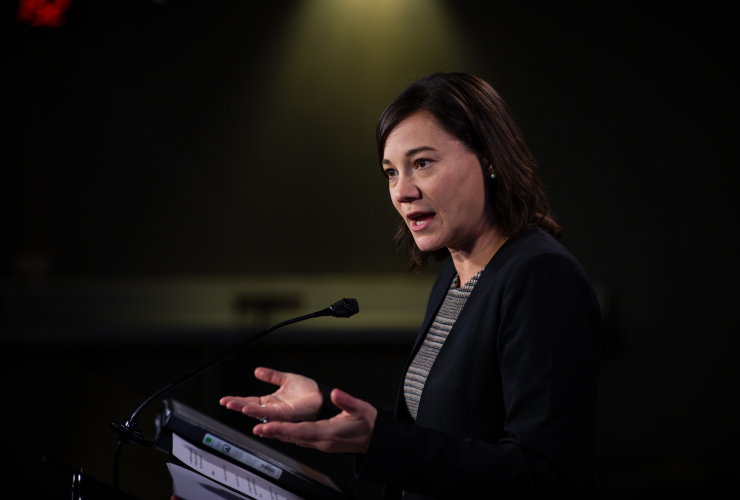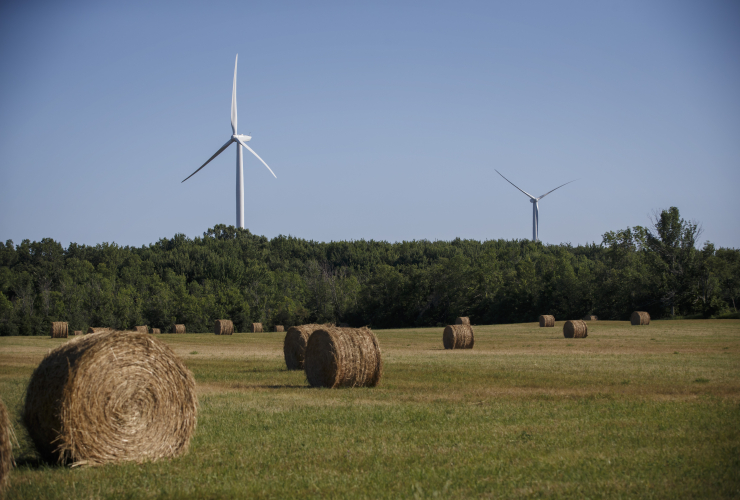Breezes of political change may be blowing across Canada, but the wind energy industry says it can insulate itself from shocks that come with new governments by offering power at competitive prices.
Brandy Gianetta, Ontario regional director for the Canadian Wind Energy Association, said her industry was surprised when Doug Ford, the province’s new Progressive Conservative premier, cancelled a contract for an 18.5-megawatt wind project and passed legislation to limit compensation for the German company installing the turbines.
“Investor confidence took a real hit,” Giannetta said in an interview. “The government can’t just be changing the rules willy-nilly.”
Gianetta said Ford’s move was a political response to the public perception that wind energy costs — rather than the huge bill for replacing decrepit transmission infrastructure — were to blame for Ontario’s skyrocketing power rates.
The Progressive Conservative government's recent decision to tear up that deal and more than 750 other renewable energy contracts was a hot topic of discussion as hundreds of delegates from wind energy companies gathered in Calgary this week to discuss the state of the industry.
Focus on keeping current share of Ontario market
Mike Richmond, an energy policy lawyer with McMillan LLP, told delegates the wind energy industry should abandon any hopes of getting more of the Ontario’s electricity market and focus instead on keeping its current eight per cent.
Richmond warned the Ford government wouldn’t hesitate to terminate contracts with renewable companies for small snafus.
“Don’t assume that contract violations will be met with a smile and a wave,” he said. “That’s not going to happen.”
Public relations consultant Frédéric Verreault said the recent change in Quebec’s government could bode well for the wind energy industry if it can supply power at rates that are competitive with hydroelectricity.
“The Coalition Avenir Québec are business people,” Verreault said. “They don’t care about consensus, they care about results.”

Uncertainty in Alberta
With Albertans set to head to the polls in the spring of 2019, there were also many questions about the impact of a potential defeat of Premier Rachel Notley’s New Democratic Party government on an industry that already supplies nearly 1,500MW to the province’s grid.
As aging coal generation plants are shuttered, the NDP government’s target is to get 30 per cent of Alberta’s electricity from renewable sources by 2030. Wind would supply the bulk of those 5,000 megawatts in a province that is home to the world's third largest reserves of crude oil after Saudi Arabia and Venezuela.
With no clear policy on renewable energy yet from Jason Kenney’s United Conservative Party, pollster Mark Henry said wind electricity suppliers need to correct mistaken impressions among opposition politicians and Albertans or risk policy changes like those in Ontario.
“Fossil fuels and wind energy are not mutually exclusive. Instead they provide for diversity and stability to the grid,” Henry said.
“Renewables and expensive are not synonymous because the cost curve for wind is headed in the right direction.”
Indeed, when an auction for wind energy was held a year ago in Alberta, there were gasps when Notley announced the weighted average price of the successful bids was 3.7 cents per kilowatt hour. The weighted average rate from an Ontario procurement of wind energy in 2016 was more than double that at 8.5 cents per kilowatt-hour.
In an interview with National Observer, the president of the Canadian Wind Energy Association noted there were significant differences between Ontario and Alberta in their initial approaches to incorporating renewables in the energy mix, however.
To start, Robert Hornung said, last year Alberta launched a competitive pricing process that put the onus on bidders to produce cheap power, and shared risk between the government and producers.
A decade earlier, Ontario promised producers price certainty to encourage market expansion. This contributed to quickly shifting the province's power grid away from coal. However, Ontario's demand for electricity was lower than anticipated because of the 2008 financial crisis, so prices were out of whack.
“Some of the lessons learned there are in terms of how to procure the power, and how to share and mitigate risks associated with fluctuations in the market, or fluctuations in price," Hornung said.
Ontario consumers ultimately paid a higher price for energy, though the province was "ahead of the curve" on renewables, Hornung said. "They also successfully undertook the largest greenhouse gas emission reduction initiative in North America by shutting down their coal facilities. They got rid of their smog days. They did stimulate some significant economic development as a result and they positioned themselves very well for a future where Ontario’s grid is now 95 per cent non-emitting."
Today, as Alberta aims for 30 per cent renewable energy, wind energy is much cheaper.
The Alberta auction added 600MW in capacity that will come on stream next year. The NDP was so happy with the price that new tenders were held this fall for another 700MW of wind energy. The results of that process will be announced in December.

Squaring wind energy with conservative politics
When neighbouring Saskatchewan held an auction for 200MW of wind generation recently, the average bid was just over $0.04 per kilowatt-hour.
Saskatchewan Environment Minister Dustin Duncan told the conference that wind energy is a key part of his government’s plan to reduce greenhouse emissions by 40 per cent by 2030 even as the right-of-centre Saskatchewan Party government rejects the federal government’s plan to impose a price on carbon.
“Prices are coming down and the technology is improving,” Duncan said.
As wind turbines have become bigger in recent years, they have become much more efficient at producing power, said Gianetta, the Canadian Wind Energy Association regional director from Ontario.
“Wind is now the lowest cost option for new generation,” she said. “The recent auctions in Alberta and Saskatchewan are proof of that.”
Jason Swaine, a Republican lawmaker from North Carolina and wind power advocate, spoke at the conference and dined with some of Kenney’s advisors during his stay in Calgary.
Swaine said his party’s position on renewables has evolved in recent years as costs have come down and it’s become clear the U.S. needs diverse sources of power to guarantee its energy security.
“Being conservative doesn’t mean having your mind shut,” he said.
– With files from Trish Audette-Longo






Comments